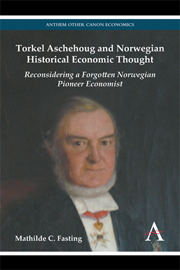 Torkel Aschehoug and Norwegian Historical Economic Thought
Torkel Aschehoug and Norwegian Historical Economic Thought Published online by Cambridge University Press: 05 March 2014
Introduction
After Schweigaard the Norwegian milieu of economists grew. Aschehoug was the natural follower of Schweigaard, but he was not alone. Some of his most prominent contemporary economists (and jurists) were Hertzberg, Aarum, Morgenstierne and Jaeger.
A presentation of Aschehoug's views on economic thought and specifically what he says about method and theory will be included. This chapter will end with a small section about the debate on methods which took place during the 1890s at the Statsøkonomisk forening. It was Oscar Jaeger who lectured about method, and the other economists participated in the debate which followed. They mostly accepted the presentation of Jaeger, at least after the turn of the century. The question was whether theoretical economics (and accordingly a more deductive method) should be divided from practical economics (accordingly a more inductive method). Aschehoug did not believe in such a sharp division between what he called the ‘pure’ and the ‘applied’ (social) economics (socialøkonomik), which is why he does not explicitly make this division through his Socialøkonomik, and why he accepts the dual use of methods, even though he distinguishes between socialøkonomik/economics and socialøkonomi/economy in the first chapter (see further comments later in this chapter).
First and foremost, is it possible to talk about a Norwegian historical school in economics? The answer is twofold. There are specific traits of a historical approach in method, namely the emphasis on studying statistics and history.
To save this book to your Kindle, first ensure [email protected] is added to your Approved Personal Document E-mail List under your Personal Document Settings on the Manage Your Content and Devices page of your Amazon account. Then enter the ‘name’ part of your Kindle email address below. Find out more about saving to your Kindle.
Note you can select to save to either the @free.kindle.com or @kindle.com variations. ‘@free.kindle.com’ emails are free but can only be saved to your device when it is connected to wi-fi. ‘@kindle.com’ emails can be delivered even when you are not connected to wi-fi, but note that service fees apply.
Find out more about the Kindle Personal Document Service.
To save content items to your account, please confirm that you agree to abide by our usage policies. If this is the first time you use this feature, you will be asked to authorise Cambridge Core to connect with your account. Find out more about saving content to Dropbox.
To save content items to your account, please confirm that you agree to abide by our usage policies. If this is the first time you use this feature, you will be asked to authorise Cambridge Core to connect with your account. Find out more about saving content to Google Drive.